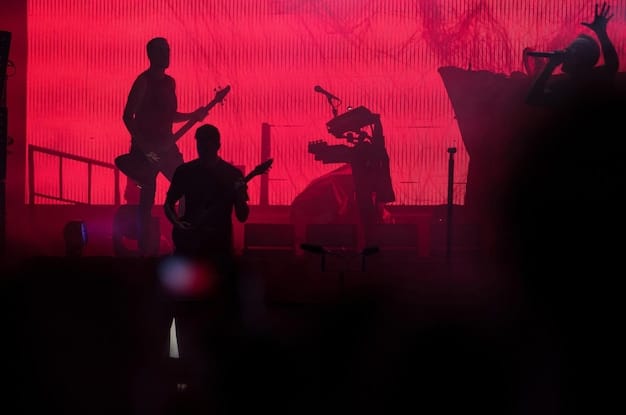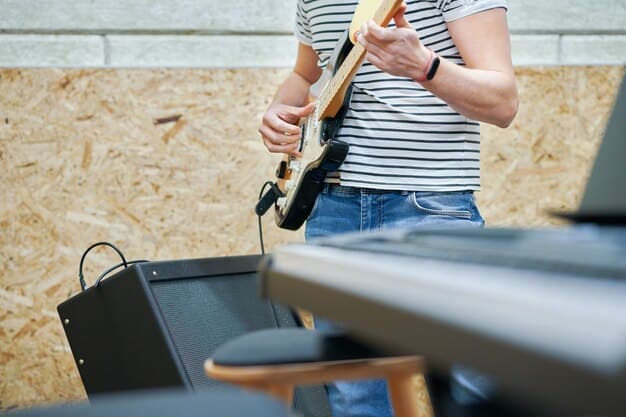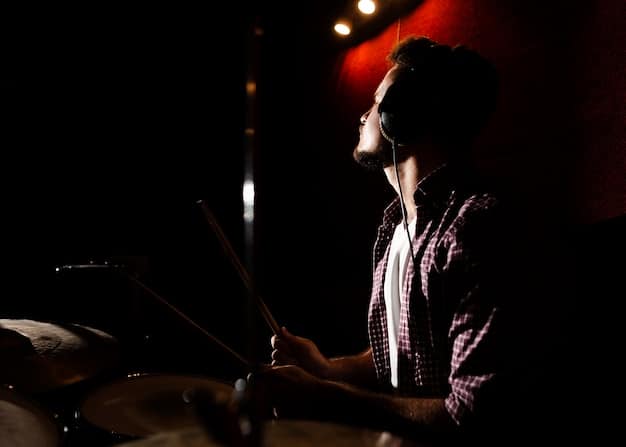Bedroom to Stage: Live Performance Tips for Underground Musicians

For underground musicians, effectively preparing for live performances means diligently mastering a blend of technical proficiency, logistical planning, and mental readiness, transforming raw talent into captivating stage presence to connect with an audience while navigating the unique challenges of the indie music scene.
Venturing from the intimate confines of a personal creative space to the vibrant energy of a live stage presents a unique set of challenges and opportunities for any aspiring artist. For underground musicians seeking to transition from bedroom to stage: practical tips for live performances are indispensable, promising to transform raw passion into compelling artistry.
Mastering Your Craft: Rehearsal and Technical Proficiency
The foundation of any memorable live performance is built upon rigorous preparation and an unwavering commitment to technical excellence. For an underground musician, this phase is where the raw sounds conceived in solitude truly begin to take shape for an audience.
Structured Rehearsal Sessions
Effective rehearsals are not merely about playing songs repeatedly. They are strategic sessions designed to refine every aspect of the performance. This includes timing, dynamics, transitions, and the overall flow of the set. Begin by establishing clear objectives for each rehearsal. Is it to iron out a specific difficult section, or to run through the entire set as if it were a live show?
- 🎯 **Set Clear Goals:** Define what you aim to achieve in each rehearsal session.
- ⏰ **Time Management:** Allocate specific times for warm-ups, new material, and full run-throughs.
- 🤝 **Constructive Feedback:** Encourage open discussion and honest feedback among band members.
- 🔊 **Simulate Live Conditions:** Practice at performance volume to acclimate to the sound.
Beyond musicality, rehearsals are the ideal time to practice stage presence and interaction. This means thinking about how you’ll move, where you’ll stand, and how you’ll engage with the audience. Consider experimenting with different arrangements or even improvisation within the structured framework of your songs to keep the performance fresh and dynamic.
A key aspect of preparation is also knowing your equipment inside out. Understanding the nuances of your instruments, effects pedals, amplifiers, and even microphones can prevent last-minute glitches. Troubleshooting simple issues rapidly during a sound check or even mid-performance can save a show, reinforcing the importance of being fully acquainted with your gear.
Equipment Readiness: Gear Up for the Gig
Even the most talented musician can falter if their equipment isn’t ready for the demands of a live show. For underground artists, who often operate with limited budgets, maximizing the reliability and efficiency of their existing gear is paramount.
Checking and Maintaining Your Instruments
Before every performance or even a crucial rehearsal, a thorough check of all instruments is non-negotiable. This involves more than just tuning. It means inspecting cables for damage, ensuring all inputs and outputs are clean, and checking battery levels for active pickups or effects pedals. A loose cable or a dying battery can ruin a pivotal moment on stage.
- 🔌 **Inspect Cables:** Look for fraying, bent connectors, or crackling sounds.
- 🔋 **Check Batteries:** Replace batteries in active pickups, pedals, and wireless units frequently.
- 🔧 **Tighten Loose Parts:** Ensure knobs, jacks, and strap buttons are secure.
- 🧼 **Clean Contacts:** Use contact cleaner for inputs, outputs, and pedal jacks to prevent signal loss.
Beyond instruments, consider your amplifier and effects chain. Are all pedals powered correctly? Is the signal chain optimized to minimize noise and maximize tone? Bringing spare parts—such as strings, batteries, and even a backup cable—can be a lifesaver. These small preventative measures can avert major disasters and ensure a seamless flow during your set.

Ultimately, equipment readiness extends to understanding the venue’s technical capabilities. If possible, communicate with the venue’s sound engineer or technical manager ahead of time. Share your input list, stage plot, and any specific technical requirements. This proactive approach helps the sound crew prepare and minimizes surprises during sound check, allowing you to focus on your performance rather than technical hurdles.
The Crucial Sound Check: Tuning into Perfection
The sound check is arguably the most vital part of live performance preparation, serving as the bridge between your practice space and the actual stage environment. For underground musicians, it’s an opportunity to fine-tune your sound in a live setting, which can be drastically different from a rehearsal room.
Optimizing Your Sound for the Venue
During sound check, the goal is not just to hear yourself, but to hear how your instrument or voice interacts with the stage monitors and the main house speakers. Start with drums, then bass, guitar, keys, and finally vocals. Listen critically to each element. Is the bass muddy or clear? Are the guitars cutting through without being abrasive? Are the vocals present and intelligible?
- 👂 **Listen Critically:** Pay attention to clarity, balance, and volume for each instrument.
- 🗣️ **Communicate Clearly:** Provide specific, constructive feedback to the sound engineer.
- 🚶 **Walk the Room:** If possible, have someone stand in the audience to assess the mix.
- 🎧 **Monitor Mix:** Ensure you have enough of each instrument (including your own) in your monitors.
Don’t be afraid to ask the sound engineer to adjust levels, EQ, or effects. They are there to help you sound your best. However, also be mindful of time; sound checks can be limited, so prioritize the most important adjustments. It’s also wise to have a pre-determined song or section that you can play to help the engineer dial in your sound quickly, ideally one that utilizes the full dynamic range of your performance.
Remember that the stage environment itself can affect your sound. Low ceilings might create more bass resonance, while higher ceilings could make the sound more diffuse. A good sound check allows you to anticipate and compensate for these acoustic peculiarities, ensuring a cohesive and impactful sound for your audience regardless of the venue’s characteristics.
Stage Presence: Connecting Beyond the Music
While musical proficiency is essential, genuine connection with an audience often hinges on compelling stage presence. It’s about more than just playing; it’s about performing, engaging, and telling a story that resonates with those watching.
Engaging Your Audience
Stage presence begins before you even play the first note. It’s in the way you walk onto the stage, the initial eye contact with the crowd, and your overall demeanor. Throughout the performance, make an effort to connect. This can be through eye contact, brief spontaneous remarks, or even just acknowledging applause with a genuine smile.
- 👁️ **Make Eye Contact:** Connect with individual audience members, even briefly.
- 🗣️ **Talk to the Crowd:** Share anecdotes, introduce songs, or simply express gratitude.
- 🕺 **Movement and Energy:** Use the stage space, move with the music, and project energy.
- 🎭 **Show Emotion:** Let your facial expressions and body language reflect the mood of your music.
Authenticity is key. Don’t try to be something you’re not. Let your personality shine through. If your music is high-energy, let your movements be energetic. If it’s more introspective, convey that through subtle gestures and powerful stillness. Practical tips also include avoiding looking at your feet or always at your bandmates; instead, spread your attention across the audience and the stage.
Consider the pauses between songs as part of the performance. Use them to recalibrate, interact with the audience, or set the mood for the next piece. Even small, deliberate actions, like adjusting a microphone with purpose or making a confident stride across the stage, contribute to an overall sense of professionalism and mastery that captivates an audience.
Managing Performance Anxiety: Staying Grounded Under Pressure
Regardless of experience level, performance anxiety can affect any musician. For underground artists stepping into the spotlight, managing these nerves is crucial for delivering a stellar performance and genuinely enjoying the experience.
Techniques for Calming Nerves
Acknowledge that some level of anxiety is normal and can even be beneficial, channeling it into heightened focus and energy. However, excessive anxiety can hinder your performance. Deep breathing exercises are simple yet profoundly effective. Before stepping on stage, take several slow, deep breaths to calm your nervous system.
- 💨 **Deep Breathing:** Practice diaphragmatic breathing to regulate your heart rate.
- 🧘 **Visualization:** Imagine a successful, powerful performance before you go on stage.
- 💪 **Warm-up Thoroughly:** Physical and vocal warm-ups can reduce tension.
- 💧 **Stay Hydrated:** Dehydration can exacerbate anxiety symptoms.

Familiarity breeds confidence. The more you rehearse and perform, the more comfortable you’ll become. If you’re particularly prone to anxiety, consider performing for small, supportive audiences first, gradually increasing the size of your crowd. Understanding that the audience is there to enjoy your music, not to judge you harshly, can also shift your perspective.
Create a pre-performance routine that helps you center yourself. This might include listening to a specific playlist, meditating for a few minutes, or simply reviewing your setlist. Having a ritual can provide a sense of control and normalcy amidst the pre-gig hustle, allowing you to walk onto the stage feeling more grounded and ready to share your art.
Logistics and Promotion: Beyond the Music Itself
For underground musicians, live performances are not just about the music; they’re also a vital tool for growth, networking, and building a fanbase. Effective logistical planning and strategic promotion are as important as the notes you play.
Organizing Your Gig Day
A well-organized gig day minimizes stress and allows you to focus on your performance. Create a detailed checklist for everything you need: instruments, cables, spares, merchandise, setlists, and even personal items. Confirm load-in times, sound check schedules, and stage times with the venue well in advance. Arriving early can sometimes offer extra sound check time or simply a more relaxed setup.
- 📝 **Detailed Checklist:** Create a comprehensive list of all gear and essentials.
- 📞 **Confirm Schedule:** Double-check times for load-in, sound check, and performance.
- 🚗 **Plan Transportation:** Ensure your gear can be moved efficiently and safely.
- 💰 **Merch Management:** Organize your merchandise for easy display and sales.
Promotion starts long before the gig day. Utilize social media, local music blogs, and personal networks to spread the word. Create engaging event pages, share snippets of your music, and interact directly with potential attendees. On the day of the show, remind your followers, share location details, and encourage last-minute attendance. Having a friend or band member dedicated to capturing photos and videos during the performance can also provide valuable content for future promotion.
Finally, cultivating relationships with venue staff, sound engineers, and other bands is invaluable. A good reputation within the local music scene can lead to more opportunities, better slots, and a supportive network. Thank the venue, be respectful of their rules, and stick to your schedule. These professional courtesies can make a significant difference in your journey from the bedroom to the stage.
| Key Area | Brief Description |
|---|---|
| 🎶 Performance Prep | Rigorous rehearsals and instrument mastery are foundational for a captivating live show. |
| 🎸 Gear Readiness | Thorough equipment checks, maintenance, and spares prevent mid-performance glitches. |
| 🎤 Sound Check | Optimizing your sound with the engineer ensures clarity and balance in the venue. |
| 🌟 Stage Presence | Engaging the audience through movement, eye contact, and authentic interaction. |
Frequently Asked Questions
▼
Audience interaction is highly important as it transforms a performance from merely playing songs into a memorable shared experience. It builds rapport, makes the audience feel involved, and can significantly amplify the energy in the room, creating a stronger connection between the musicians and their listeners. Even subtle gestures can make a difference.
▼
A comprehensive gig checklist should include all instruments, amplifiers, effect pedals, power supplies, cables (audio, instrument, power), spare strings and batteries, tuners, picks, a setlist, personal protective equipment (earplugs), and any merchandise for sale. It’s also smart to include contact information for the venue and a basic repair kit.
▼
Effective promotion on a budget involves leveraging free online tools: social media platforms (Instagram, TikTok, Facebook events), local online music calendars, and direct email lists. Designing simple digital flyers, collaborating with other local bands, and encouraging word-of-mouth through personal invites are also highly effective strategies. Utilize captivating content like behind-the-scenes rehearsal footage.
▼
Firstly, stay calm. Acknowledge the issue professionally without dwelling on it, and signal the sound engineer if needed. Have a plan for common issues, such as quickly swapping a bad cable or having a backup instrument ready. Sometimes, a brief, lighthearted comment to the audience can ease tension while the problem is resolved, keeping the overall mood positive.
▼
Yes, sound checks are absolutely necessary for every live show, regardless of size. Each venue has unique acoustic properties, and every sound system set up will differ. A proper sound check ensures your instruments and vocals are balanced, clear, and projected optimally to the audience, guaranteeing a consistent and high-quality auditory experience for your listeners.
Conclusion
The journey from the intimate settings of bedroom creation to the electrifying presence of a live stage is a transformative one for any musician. For underground artists, this transition demands more than just musical talent; it requires meticulous preparation, technical foresight, a keen understanding of audience engagement, and strategic logistical planning. By embracing rigorous rehearsals, ensuring equipment readiness, utilizing sound checks effectively, cultivating compelling stage presence, and managing performance anxiety with proven techniques, musicians can confidently transform their artistic vision into a captivating live experience. These practical tips are not mere suggestions but foundational pillars that support not only a successful performance but also the sustainable growth of an artist’s career, fostering genuine connection and leaving a lasting impression on listeners.





